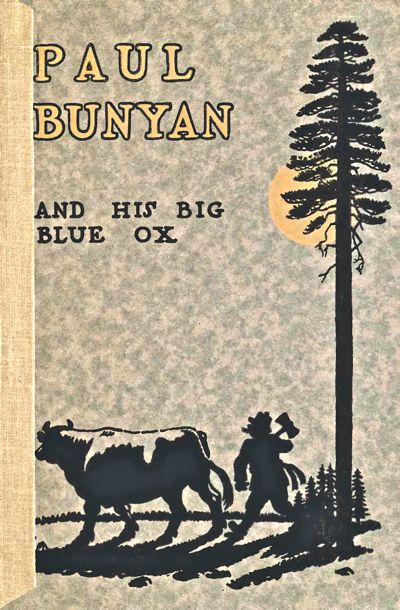
Title: The Marvelous Exploits of Paul Bunyan
Author: William B. Laughead
Release date: June 28, 2010 [eBook #32994]
Language: English
Credits: E-text prepared by David Edwards, Ernest Schaal, and the Project Gutenberg Online Distributed Proofreading Team (http://www.pgdp.net) from scanned images of public domain material generously made available by Microsoft's Live Search Books
| Note: | Images of the original pages were available through the Microsoft Search Book project, which was discontinued by Microsoft in 2008. These images, or a remarkably similar set, are now available though Internet Archive. See http://www.archive.org/details/marvelousexploit00laugiala |

The Marvelous Exploits of
AS TOLD IN THE CAMPS
OF THE WHITE PINE LUMBERMEN FOR
GENERATIONS
DURING WHICH TIME THE LOGGERS
HAVE PIONEERED THE WAY THROUGH
THE NORTH WOODS
FROM MAINE TO CALIFORNIA
Collected from Various Sources and
Embellished for Publication
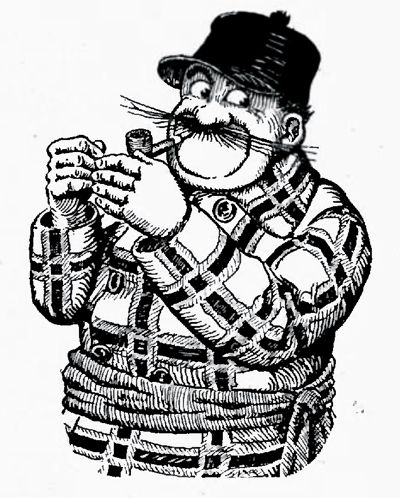
Text and Illustrations
By
W. B. Laughead
Published for the Amusement
of our Friends by
MINNEAPOLIS, WESTWOOD, CAL., CHICAGO,
LOS ANGELES -:- SAN FRANCISCO
NINETEEN TWENTY-TWO
PAUL Bunyan is the hero of lumbercamp whoppers that have been handed down for generations. These stories, never heard outside the haunts of the lumberjack until recent years, are now being collected by learned educators and literary authorities who declare that Paul Bunyan is "the only American myth."
The best authorities never recounted Paul Bunyan's exploits in narrative form. They made their statements more impressive by dropping them casually, in an off hand way, as if in reference to actual events of common knowledge. To over awe the greenhorn in the bunkshanty, or the paper-collar stiffs and home guards in the saloons, a group of lumberjacks would remember meeting each other in the camps of Paul Bunyan. With painful accuracy they established the exact time and place, "on the Big Onion the winter of the blue snow" or "at Shot Gunderson's camp on the Tadpole the year of the sourdough drive." They elaborated on the old themes and new stories were born in lying contests where the heights of extemporaneous invention were reached.
In these conversations the lumberjack often took on the mannerisms of the French Canadian. This was apparently done without special intent and no reason for it can be given except for a similarity in the mock seriousness of their statements and the anti-climax of the bulls that were made, with the braggadocio of the habitant. Some investigators trace the origin of Paul Bunyan to Eastern Canada. Who can say?
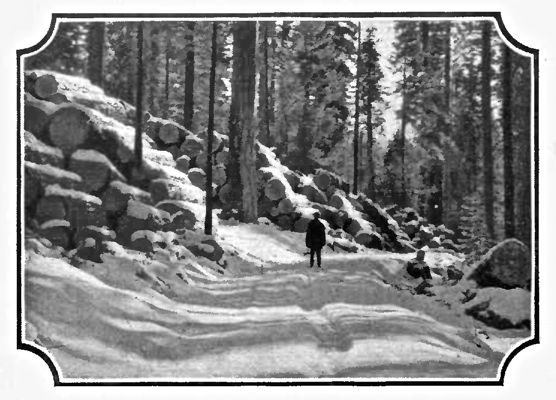 Logging Road near Westwood, California. White Pine and
Old Fashioned Winters made Paul Bunyan feel at home.
Logging Road near Westwood, California. White Pine and
Old Fashioned Winters made Paul Bunyan feel at home.
PAUL Bunyan came to Westwood, California in 1913 at the suggestion of some of the most prominent loggers and lumbermen in the country. When the Red River Lumber Company announced their plans for opening up their forests of Sugar Pine and California White Pine, friendly advisors shook their heads and said,
"Better send for Paul Bunyan."
Apparently here was the job for a Superman,—quality-and-quantity-production on a big scale and great engineering difficulties to be overcome. Why not Paul Bunyan? This is a White Pine job and here in the High Sierras the winter snows lie deep, just like the country where Paul grew up. Here are trees that dwarf the largest "cork pine" of the Lake States and many new stunts were planned for logging, milling and manufacturing a product of supreme quality—just the job for Paul Bunyan.
The Red River people had been cutting White Pine in Minnesota for two generations; the crews that came west with them were old heads and every one knew Paul Bunyan of old. Paul had followed the White Pine from the Atlantic seaboard west to the jumping-off place in Minnesota, why not go the rest of the way?

Paul Bunyan's picture had never been published until he joined Red River and this likeness, first issued in 1914, is now the Red River trademark. It stands for the quality and service you have the right to expect from Paul Bunyan.
When and where did this mythical hero get his start? Paul Bunyan is known by his mighty works; his antecedents and personal history are lost in doubt. You can prove that Paul logged off North Dakota and grubbed the stumps, not only by the fact that there are no traces of pine forests in that State, but by the testimony of oldtimers who saw it done. On the other hand, Paul's parentage and birth date are unknown. Like Topsy, he jes' growed.
Nobody cared to know his origin until the professors got after him. As long as he stayed around the camps his previous history was treated with the customary consideration and he was asked no questions, but when he broke into college it was all off. Then he had to have ancestors, a birthday and all sorts of vital statistics. For now Paul is recognized as a regular Myth and students of folk-lore are making scientific research of the Paul Bunyan Legend.
R. R. Fenska, Professor of Forest Engineering, New York State College of Forestry, Syracuse University, an authority on Paul Bunyan, writes: "He is not only an all-American myth but as far as can be determined, the only myth or legend in this country. It is all-American because Paul's exploits are all accomplished on this continent and there is no counterpart in the Old World. The origin of Paul is as much a myth as the legend itself. There are some who feel that he was known in the Northeastern forest back in the early 19th century but the best available evidence points to the pineries of the Lake States as the "Mother" of Paul Bunyan. It is certain that he developed to the zenith of his powers in that region during the '80s and '90s."
Professor Fenska points out that Paul was a "Northerner" for when the virgin forests of the Lake States began to wane and the lumberjack shifted to the Southern Yellow Pine region, little was heard of him for nearly a decade. Noting his reappearance on the Pacific Coast, this authority discounts the rumors that Paul has gone to Alaska and expresses the opinion that his greatest exploits will take place in the vast forests of the west.
Esther Shepherd, Department of English, Reed College, Portland, Oregon has traced the Paul Bunyan legend back to Maine but finds evidence of beginnings that antedate the Maine epoch and is still carrying on her painstaking search for the ultimate source. Writing in the Pacific Review, Mrs. Shepherd relates this one about Paul's babyhood.
"Paul Bunyan was born in Maine. When three weeks old he rolled around so much in his sleep that he destroyed four square miles of standing timber. Then they built a floating cradle for him and anchored it off Eastport. When Paul rocked in his cradle it caused a seventy-five foot tide in the Bay of Fundy and several villages were washed away. He couldn't be wakened, however, until the British Navy was called out and fired broadsides for seven hours. When Paul stepped out of his cradle he sank seven warships and the British government seized his cradle and used the timber to build seven more. That saved Nova Scotia from becoming an island, but the tides in the Bay of Fundy haven't subsided yet."
"Seeing that this North American Continent has only one myth that is entirely it's own" J. M. Leever of the Pacific Lumber Company writes in a San Francisco paper, "It is a pity that it should have been in danger of being forgotten." After paying tribute to the work of Prof. Fenska and the University of Oregon Mr. Leever continues, "Where the tradition of this Davy Crockett of the axe, this superman of the camps originated, nobody can tell exactly. But it is probable that the stories of his courage and impossible feats started on the St. Lawrence among the French Canadians and filtered into the woods of the Adirondacks, Michigan and Wisconsin. Although at times very human, Paul Bunyan in his bigger moments far surpassed any of the figures of classical Scandinavian or Celtic legend. For the sake of the young of the land his memory ought to be kept forever fresh."
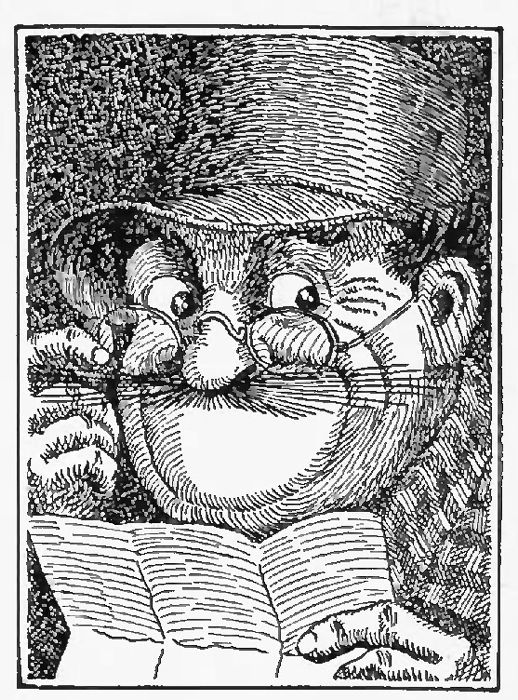
Lee J. Smits conducted a "Paul Bunyan" column in The Seattle Star and published many entertaining contributions from oldtimers. These were turned over to the University of Washington for preservation.
"Standing alone in his might and inventiveness is Paul Bunyan, central figure in America's meager folklore" Mr. Smits says editorially, "Only among the pioneers could Paul thrive, his deeds are inspired by such imagination as grows only in the great outdoors. For hours at a time, lumberjacks will pile up the achievements of their hero. Each story is a challenge calling for a yarn still more heroic. The story teller who succeeds in eliciting a snicker is an artist, indeed, as the Paul Bunyan legends must always be related and received with perfect seriousness. Paul Bunyan has become a part of the every day life of the loggers. He serves a valuable purpose in giving every hardship and tough problem its whimsical turn."
Mr. Harry L. Neall, of Harry L. Neall & Son, Mining Engineers of Eureka, Cal., a student of the history of the lumber industry, has written that beneath the phrase "invented lumbering" used in connection with Paul Bunyan, there exists a basis of fact. Tracing the beginnings of the industry from the cutting of "The King's Spars" in what is now the State of Maine, before the Mayflower came to Plymouth Rock, Mr. Neall states that "modern lumbering, as a separate industry was really invented in New York in 1790 and that most of the oldtime lumbermen trace their ancestry to forefathers who were a part of this beginning of lumbering." The Red River people were interested to learn from Mr. Neall that a Walker built a mill in Maine in 1680; another Walker sold a two-thirds interest in this mill in 1716 and three Walkers were saw mill owners in New Hampshire in 1785. Following the Pine Cutters across New York and Pennsylvania, Mr. Neall found that the land records enable one to pick them out by their names "as distinguished from the Palatinate settlers who came solely for the farm lands upon which the hardwoods grew." That the Paul Bunyan stories go back to the beginnings of the industry is the belief of Mr. Neall who heard them in his grandfather's logging camps in Pennsylvania and quotes this ancestor as connecting Paul with the early traditions.
DeWitt L. Hardy, "column conductor" on the Portland Oregonian, ran a Paul Bunyan series for several months and received many more contributions than it was possible to print, though they were featured almost daily, writes Mr. Hardy:
"Paul Bunyan is, as your folklore sharks doubtless will inform you, about the only true fable of this character we have in this country. I do not attempt to dip into any of the real sub-surface studies of its development, my experience with Paul having been severely practical. I first heard of him in a soddy in North Dakota, where I was told of his great logging operations when he stripped that country and removed the stumps. In the mass of correspondence I received while handling the Paul Bunyan yarns here, answers came from all corners of the globe and from all classes of people."
Ida V. Turney, Department of Rhetoric, University of Oregon, and President of the Oregon Council of English, has written a chapbook of Paul Bunyan stories,—"gang-lore" Miss Turney classifies them, citing technical reasons why they cannot be called "myth" "legend" or "folk-lore."
"It is distinctly American" she writes, "No other country could possibly produce a literary type just like it; for it is, at least so I think, a symbolic expression of the forces of physical labor at work in the development of a great country. The symbolism is, of course, unconscious, but none the less accurate."
Miss Turney, the daughter of a lumberman, has known these stories from childhood. "All Paul Bunyan stories start in a gang" she says, "others are imitations ... Perhaps Paul Bunyan is the great American epic; but if so it is in the making. In that case it seems to me that any gang has a perfect right to create new stories. ... Paul has become astonishingly versatile in the West. He has tried his hand at almost everything, just as the former laborers in the camps of Michigan and Wisconsin branched into whatever big wild untamed hard work they came across."
BABE, the big blue ox, constituted Paul Bunyan's assets and liabilities. History disagrees as to when, where and how Paul first acquired this bovine locomotive but his subsequent record is reliably established. Babe could pull anything that had two ends to it.

Babe was seven axehandles wide between the eyes according to some authorities; others equally dependable say forty-two axehandles and a plug of tobacco. Like other historical contradictions this comes from using different standards. Seven of Paul's axehandles were equal to a little more than forty-two of the ordinary kind.
When cost sheets were figured on Babe, Johnny Inkslinger found that upkeep and overhead were expensive but the charges for operation and depreciation were low and the efficiency was very high. How else could Paul have hauled logs to the landing a whole section (640 acres) at a time? He also used Babe to pull the kinks out of the crooked logging roads and it was on a job of this kind that Babe pulled a chain of three-inch links out into a straight bar.
They could never keep Babe more than one night at a camp for he would eat in one day all the feed one crew could tote to camp in a year. For a snack between meals he would eat fifty bales of hay, wire and all and six men with picaroons were kept busy picking the wire out of his teeth. Babe was a great pet and very docile as a general thing but he seemed to have a sense of humor and frequently got into mischief. He would sneak up behind a drive and drink all the water out of the river, leaving the logs high and dry. It was impossible to build an ox-sling big enough to hoist Babe off the ground for shoeing, but after they logged off Dakota there was room for Babe to lie down for this operation.
Once in a while Babe would run away and be gone all day roaming all over the Northwestern country. His tracks were so far apart that it was impossible to follow him and so deep that a man falling into one could only be hauled out with difficulty and a long rope. Once a settler and his wife and baby fell into one of these tracks and the son got out when he was fifty-seven years old and reported the accident. These tracks, today form the thousands of lakes in the "Land of the Sky-Blue Water."
BECAUSE he was so much younger than Babe and was brought to camp when a small calf, Benny was always called the Little Blue Ox although he was quite a chunk of an animal. Benny could not, or rather, would not haul as much as Babe nor was he as tractable but he could eat more.
Paul got Benny for nothing from a farmer near Bangor, Maine. There was not enough milk for the little fellow so he had to be weaned when three days old. The farmer only had forty acres of hay and by the time Benny was a week old he had to dispose of him for lack of food. The calf was undernourished and only weighed two tons when Paul got him. Paul drove from Bangor out to his headquarters camp near Devil's Lake, North Dakota that night and led Benny behind the sleigh. Western air agreed with the little calf and every time Paul looked back at him he was two feet taller.
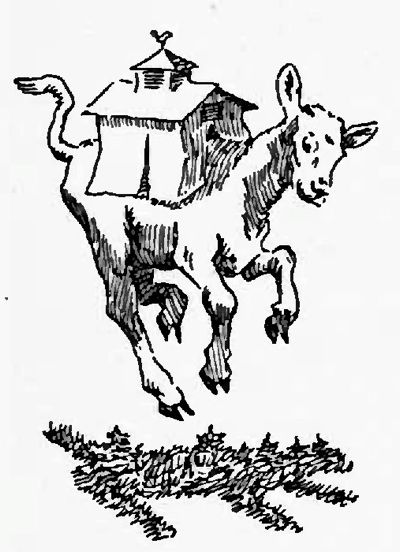
When they arrived at camp Benny was given a good feed of buffalo milk and flapjacks and put into a barn by himself. Next morning the barn was gone. Later it was discovered on Benny's back as he scampered over the clearings. He had outgrown his barn in one night.

Benny was very notional and would never pull a load unless there was snow on the ground so after the spring thaws they had to white wash the logging roads to fool him.
Gluttony killed Benny. He had a mania for pancakes and one cook crew of two hundred men was kept busy making cakes for him. One night he pawed and bellowed and threshed his tail about till the wind of it blew down what pine Paul had left standing in Dakota. At breakfast time he broke loose, tore down the cook shanty and began bolting pancakes. In his greed he swallowed the red-hot stove. Indigestion set in and nothing could save him. What disposition was made of his body is a matter of dispute. One oldtimer claims that the outfit he works for bought a hind quarter of the carcass in 1857 and made corned beef of it. He thinks they have several carloads of it left.
Another authority states that the body of Benny was dragged to a safe distance from the North Dakota camp and buried. When the earth was shoveled back it made a mound that formed the Black Hills in South Dakota.
THE custodian and chaperon of Babe the Big Blue Ox was Brimstone Bill. He knew all the tricks of that frisky giant before they happened.
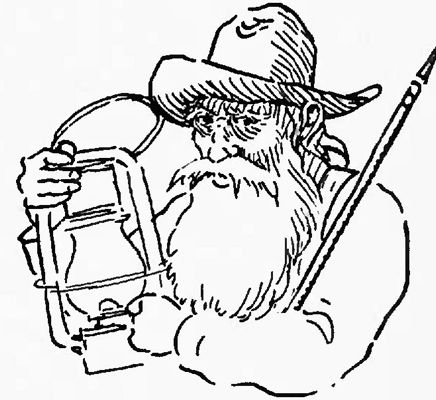
"I know oxen" the old bullwhacker used to say, "I've worked 'em and fed 'em and doctored 'em ever since the ox was invented. And Babe, I know that pernicious old reptyle same as if I'd abeen through him with a lantern."
Bill compiled "The Skinner's Dictionary", a hand book for teamsters, and most of the terms used in directing draft animals (except mules) originated with him. His early religious training accounts for the fact that the technical language of the teamster contains so many names of places and people spoken of in the Bible.
The buckskin harness used on Babe and Benny when the weather was rainy was made by Brimstone Bill. When this harness got wet it would stretch so much that the oxen could travel clear to the landing and the load would not move from the skidway in the woods. Brimstone would fasten the harness with an anchor Big Ole made for him and when the sun came out and the harness shrunk the load would be pulled to the landing while Bill and the oxen were busy at some other job.
The winter of the Blue Snow, the Pacific Ocean froze over and Bill kept the oxen busy hauling regular white snow over from China. M. H. Keenan can testify to the truth of this as he worked for Paul on the Big Onion that winter. It must have been about this time that Bill made the first ox yokes out of cranberry wood.

FEEDING Paul Bunyan's crews was a complicated job. At no two camps were conditions the same. The winter he logged off North Dakota he had 300 cooks making pancakes for the Seven Axemen and the little Chore-boy. At headquarters on the Big Onion he had one cook and 462 cookees feeding a crew so big that Paul himself never knew within several hundred either way, how many men he had.
At Big Onion camp there was a lot of mechanical equipment and the trouble was a man who could handle the machinery cooked just like a machinist too. One cook got lost between the flour bin and the root cellar and nearly starved to death before he was found.
Cooks came and went. Some were good and others just able to get by. Paul never kept a poor one, very long. There was one jigger who seemed to have learned to do nothing but boil. He made soup out of everything and did most of his work with a dipper. When the big tote-sled broke through the ice on Bull Frog Lake with a load of split peas, he served warmed up lake water till the crew struck. His idea of a lunch box was a jug or a rope to freeze soup onto like a candle. Some cooks used too much grease. It was said of one of these that he had to wear calked shoes to keep from sliding out of the cook-shanty and rub sand on his hands when he picked anything up.
There are two kinds of camp cooks, the Baking Powder Bums and the Sourdough Stiffs. Sourdough Sam belonged to the latter school. He made everything but coffee out of Sourdough. He had only one arm and one leg, the other members having been lost when his sourdough barrel blew up. Sam officiated at Tadpole River headquarters, the winter Shot Gunderson took charge.
After all others had failed at Big Onion camp, Paul hired his cousin Big Joe who came from three weeks below Quebec. This boy sure put a mean scald on the chuck. He was the only man who could make pancakes fast enough to feed the crew. He had Big Ole, the blacksmith make him a griddle that was so big you couldn't see across it when the steam was thick. The batter, stirred in drums like concrete mixers, was poured on with cranes and spouts. The griddle was greased by colored boys who skated over the surface with hams tied to their feet. They had to have colored boys to stand the heat.
At this camp the flunkeys wore roller skates and an idea of the size of the tables is gained from the fact that they distributed the pepper with four-horse teams.
Sending out lunch and timing the meals was rendered difficult by the size of the works which required three crews—one going to work, one on the job and one coming back. Joe had to start the bull-cook out with the lunch sled two weeks ahead of dinner time. To call the men who came in at noon was another problem. Big Ole made a dinner horn so big that no one could blow it but Big Joe or Paul himself. The first time Joe blew it he blew down ten acres of pine. The Red River people wouldn't stand for that so the next time he blew straight up but this caused severe cyclones and storms at sea so Paul had to junk the horn and ship it East where later it was made into a tin roof for a big Union Depot.
 MT. LASSEN, CALIFORNIA
MT. LASSEN, CALIFORNIAWhen Big Joe came to Westwood with Paul, he started something. About that time you may have read in the papers about a volcanic eruption at Mt. Lassen, heretofore extinct for many years. That was where Big Joe dug his bean-hole and when the steam worked out of the bean kettle and up through the ground, everyone thought the old hill had turned volcano. Every time Joe drops a biscuit they talk of earthquakes.
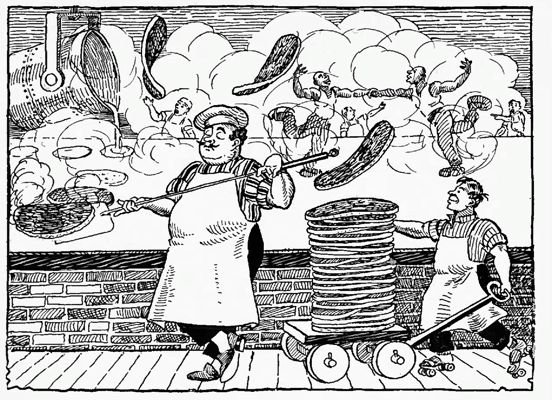
It was always thought that the quality of the food at Paul's Camps had a lot to do with the strength and endurance of the men. No doubt it did, but they were a husky lot to start with. As the feller said about fish for a brain food, "It won't do you no good unless there is a germ there to start with."
There must have been something to the food theory for the chipmunks that ate the prune pits got so big they killed all the wolves and years later the settlers shot them for tigers.
A visitor at one of Paul's camps was astonished to see a crew of men unloading four-horse logging sleds at the cook shanty. They appeared to be rolling logs into a trap door from which poured clouds of steam.
"That's a heck of a place to land logs" he remarked.
"Them aint logs" grinned a bull-cook "them's sausages for the teamsters' breakfast."
At Paul's camp up where the little Gimlet empties into the Big Auger, newcomers used to kick because they were never served beans. The bosses and the men could never be interested in beans. E. E. Terrill tells us the reason:
Once when the cook quit they had to detail a substitute to the job temporarily. There was one man who was no good anywhere. He had failed at every job. Chris Crosshaul, the foreman, acting on the theory that every man is good somewhere, figured that this guy must be a cook, for it was the only job he had not tried. So he was put to work and the first thing he tackled was beans. He filled up a big kettle with beans and added some water. When the heat took hold the beans swelled up till they lifted off the roof and bulged out the walls. There was no way to get into the place to cook anything else, so the whole crew turned in to eat up the half cooked beans. By keeping at it steady they cleaned them up in a week and rescued the would-be-cook. After that no one seemed to care much for beans.

It used to be a big job to haul prune pits and coffee grounds away from Paul's camps. It required a big crew of men and either Babe or Benny to do the hauling. Finally Paul decided it was cheaper to build new camps and move every month.
The winter Paul logged off North Dakota with the Seven Axemen, the Little Chore Boy and the 300 cooks, he worked the cooks in three shifts—one for each meal. The Seven Axemen were hearty eaters; a portion of bacon was one side of a 1600-pound pig. Paul shipped a stern-wheel steamboat up Red River and they put it in the soup kettle to stir the soup.
Like other artists, cooks are temperamental and some of them are full of cussedness but the only ones who could sass Paul Bunyan and get away with it were the stars like Big Joe and Sourdough Sam.

The lunch sled,—most popular institution in the lumber industry! It's arrival at the noon rendezvous has been hailed with joy by hungry men on every logging job since Paul invented it. What if the warm food freezes on your tin plate, the keen cold air has sharpened your appetite to enjoy it. The crew that toted lunch for Paul Bunyan had so far to travel and so many to feed they hauled a complete kitchen on the lunch sled, cooks and all.
OVER thirty years ago The Red River Lumber Company, foreseeing the end of their White Pine which was reached in 1915, set out to find the pine that would supply a trade that demands the qualities found in White Pine. All the forests of North America were examined and exhaustively studied and the selection was Sugar Pine and California White Pine,—"the largest pines that ever grew" and production started at Westwood in 1914.
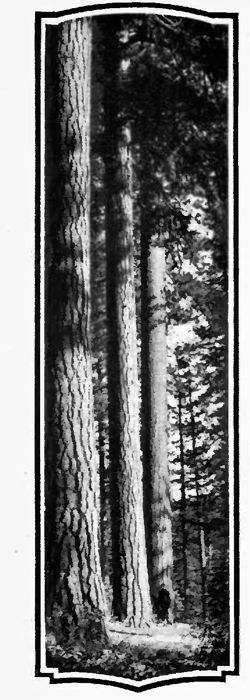
SUGAR PINE,—"cork pine's big brother," is botanically a White Pine with all the family virtues that have made White Pine the standard from the days of the Pilgrim Fathers to the period of "cork" White Pine in the Lake States. It is light, soft, even-textured, easy-to-work, durable and will not warp or check.
CALIFORNIA WHITE PINE ranks second only to Sugar Pine in size and is close to it in White Pine qualities. Botanically a Yellow Pine, its texture has been so changed by climate and altitude that it in no way resembles the Yellow Pines and is so much like White Pine that its trade name is necessary to prevent confusion on the part of the consumer.
WHITE FIR is light, straight grained and easily worked. A smaller percentage of upper grades than the big pines, but with knots so small that the commons offer exceptional values and advantages. It is used for concrete forms, sheathing, studding and for dairy containers and packages that must be odorless and tasteless. It also makes a handsome interior finish.
INCENSE CEDAR is used chiefly for pencils and chests—a soft, straight-grained red cedar.
The Red River people strive for a quality of manufacture worthy of such magnificent trees. The Westwood plant, electrically operated throughout, is a new departure in its field, with a capacity of 200 million feet a year. Planned by our own engineers, much of the machinery and equipment is of our own design and new standards of efficiency, economy and precision of cutting have been set. Modern dry-kilns handle a large part of the output and yield perfectly seasoned lumber, free from drying defects, in a few days instead of the months required for air drying.
 One of the Westwood Crane Crews Piling
Lumber for Air-drying. One board at a Time
is Too Slow. The Record for One Crane—10
Hours is 678,900 Feet, Board Measure.
One of the Westwood Crane Crews Piling
Lumber for Air-drying. One board at a Time
is Too Slow. The Record for One Crane—10
Hours is 678,900 Feet, Board Measure.
The plant operates the year 'round, logging, sawing, manufacturing and shipping. Handicaps of a severe winter climate are overcome and frozen logs are thawed in a steam-heated pond. Continuous operation gives steady employment to skilled and experienced men and a rapid replacement of stocks that makes Westwood a dependable source of supply for the trade.
The large Red River factories at Westwood are equipped to supply every known need of the trade and made-to-order specialties are quickly turned out. The most modern machinery is used for cutting, finishing, glueing and other operations.
Our moldings, sash and doors and similar products are superior in their clean-cut workmanship as well as the texture of the wood. Box shooks, sash and door cuttings, boards for winding fine textiles or making organ pipes, piano keys and key-beds, curtain poles and shade rollers are some of our products. Cutting out the knots and waste at the source of supply affords economies that are profitable to all wood consuming industries.
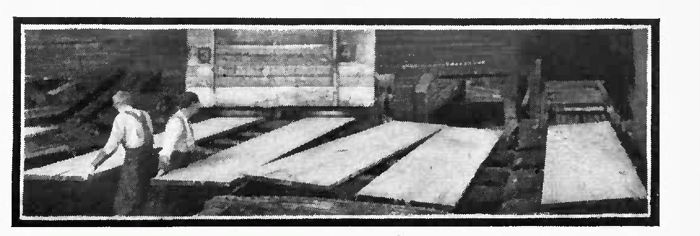 One of the Edgers, Westwood Mill, California.
One of the Edgers, Westwood Mill, California.
WHEN Paul invented logging he had to invent all the tools and figure out all his own methods. There were no precedents. At the start his outfit consisted of Babe and his big axe.
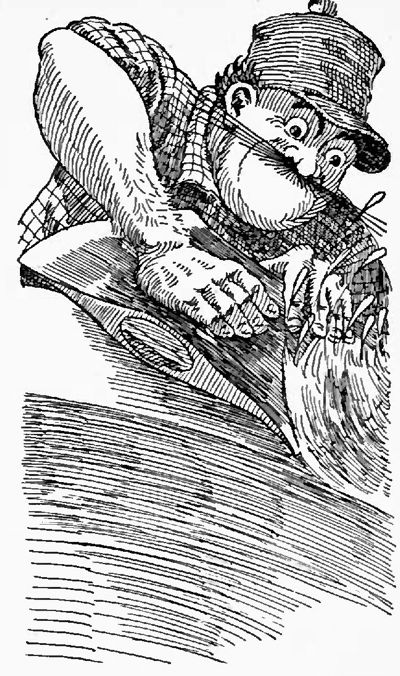
No two logging jobs can be handled exactly the same way so Paul adapted his operations to local conditions. In the mountains he used Babe to pull the kinks out of the crooked logging roads; on the Big Onion he began the system of hauling a section of land at a time to the landings and in North Dakota he used the Seven Axemen.
At that time marking logs was not thought of, Paul had no need for identification when there were no logs but his own. About the time he started the Atlantic Ocean drive others had come into the industry and although their combined cut was insignificant compared to Paul's, there was danger of confusion, and Paul had most to lose.
At first Paul marked his logs by pinching a piece out of each log. When his cut grew so large that the marking had to be detailed to the crews, the "scalp" on each log was put on with an axe, for even in those days not every man could nip out the chunk with his fingers.
The Grindstone was invented by Paul the winter he logged off North Dakota. Before that Paul's axemen had to sharpen their axes by rolling rocks down hill and running along side of them. When they got to "Big Dick," as the lumberjacks called Dakota, hills and rocks were so hard to find that Paul rigged up the revolving rock.
This was much appreciated by the Seven Axemen as it enabled them to grind an axe in a week, but the grindstone was not much of a hit with the Little Chore Boy whose job it was to turn it. The first stone was so big that working at full speed, every time it turned around once it was payday.
The Little Chore Boy led a strenuous life. He was only a kid and like all youngsters putting in their first winter in the woods, he was put over the jumps by the oldtimers. His regular work was heavy enough, splitting all the wood for the camp, carrying water and packing lunch to the men, but his hazers sent him on all kinds of wild goose errands to all parts of the works, looking for a "left-handed peavy" or a "bundle of cross-hauls."
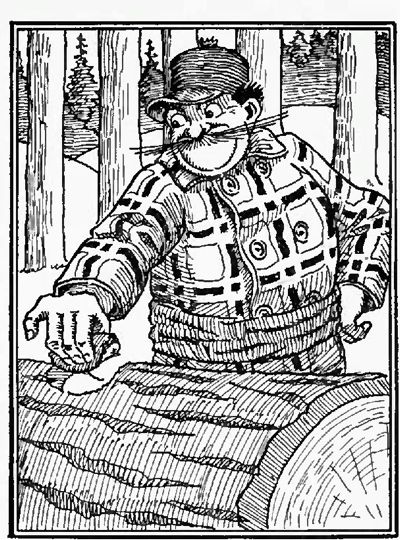
He had to take a lot of good natured roughneck wit about his size for he only weighed 800 pounds and a couple of surcingles made a belt for him. What he lacked in size he made up in grit and the men secretly respected his gameness. They said he might make a pretty good man if he ever got any growth, and considered it a necessary education to give him a lot of extra chores.
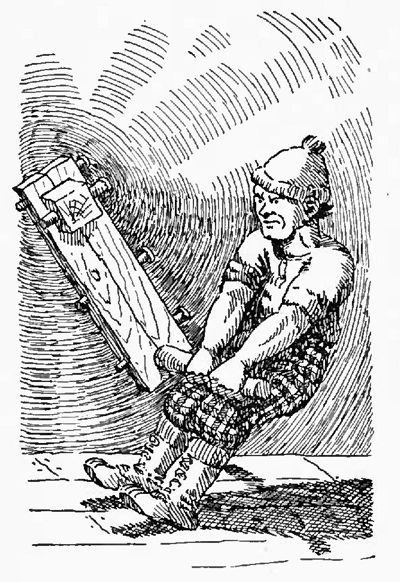
Often in the evening, after his day's work and long hours put in turning the grindstone and keeping up fires in the camp stoves—that required four cords of wood apiece to kindle a fire, he could be found with one of Big Ole's small 600-pound anvils in his lap pegging up shoes with railroad spikes.
It was a long time before they solved the problem of turning logging sleds around in the road. When a sled returned from the landing and put on a load they had to wait until Paul came along to pick up the four horses and the load and head them the other way. Judson M. Goss says he worked for Paul the winter he invented the round turn.
All of Paul's inventions were successful except when he decided to run three ten-hour shifts a day and installed the Aurora Borealis. After a number of trials the plan was abandoned because the lights were not dependable.
"THE Seven Axemen of the Red River" they were called because they had a camp on Red River with the three-hundred cooks and the Little Chore Boy. The whole State was cut over from the one camp and the husky seven chopped from dark to dark and walked to and from work.
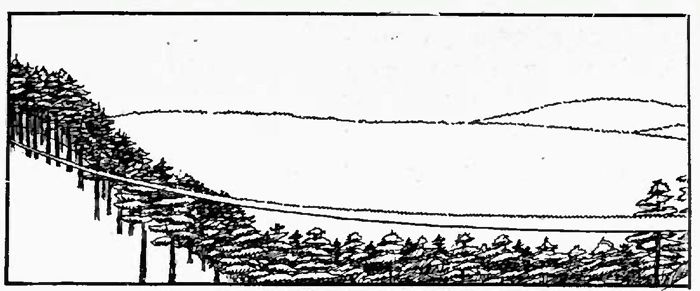
Their axes were so big it took a week to grind one of them. Each man had three axes and two helpers to carry the spare axes to the river when they got red hot from chopping. Even in those days they had to watch out for forest fires. The axes were hung on long rope handles. Each axeman would march through the timber whirling his axe around him till the hum of it sounded like one of Paul's fore-and-aft-mosquitoes, and at every step a quarter-section of timber was cut.
The height, weight and chest measurement of the Seven Axemen are not known. Authorities differ. History agrees that they kept a cord of four-foot wood on the table for toothpicks. After supper they would sit on the deacon seat in the bunk shanty and sing "Shanty Boy" and "Bung Yer Eye" till the folks in the settlements down on the Atlantic would think another nor'wester was blowing up.

Some say the Seven Axemen were Bay Chaleur men; others declare they were all cousins and came from down Machias way. Where they came from or where they went to blow their stake after leaving Paul's camp no one knows but they are remembered as husky lads and good fellows around camp.
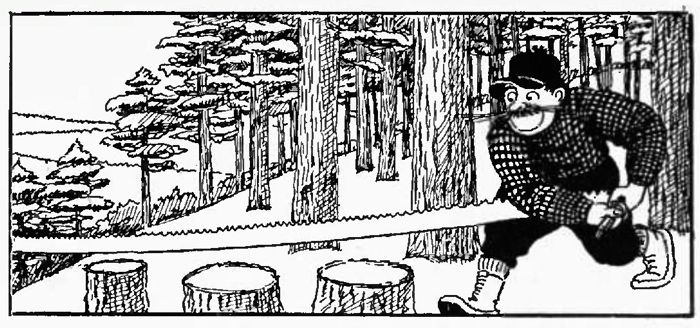
After the Seven Axemen had gone down the tote road, never to return, Paul Bunyan was at a loss to find a method of cutting down trees that would give him anything like the output he had been getting. Many trials and experiments followed and then Paul invented the two-man saw.
The first saw was made from a strip trimmed off in making Big Joe's dinner horn and was long enough to reach across a quarter section, for Paul could never think in smaller units. This saw worked all right in a level country, in spite of the fact that all the trees fell back on the saw, but in rough country only the trees on the hill tops were cut. Trees in the valleys were cut off in the tops and in the pot holes the saw passed over the trees altogether.
It took a good man to pull this saw in heavy timber when Paul was working on the other end. Paul used to say to his fellow sawyer, "I don't care if you ride the saw, but please don't drag your feet." A couple of cousins of Big Ole's were given the job and did so well that ever afterward in the Lake States the saw crews have generally been Scandinavians.
It was after this that Paul had Big Ole make the "Down-Cutter." This was a rig like a mowing machine. They drove around eight townships and cut a swath 500 feet wide.
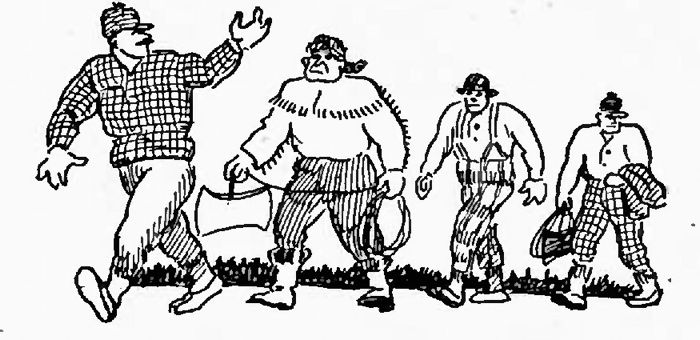
THE Winter of the Deep Snow everything was buried. Paul had to dig down to find the tops of the tallest White Pines. He had the snow dug away around them and lowered his sawyers down to the base of the trees. When the tree was cut off he hauled it to the surface with a long parbuckle chain to which Babe, mounted on snowshoes, was hitched. It was impossible to get enough stove pipe to reach to the top of the snow, so Paul had Big Ole make stovepipe by boring out logs with a long six-inch auger.
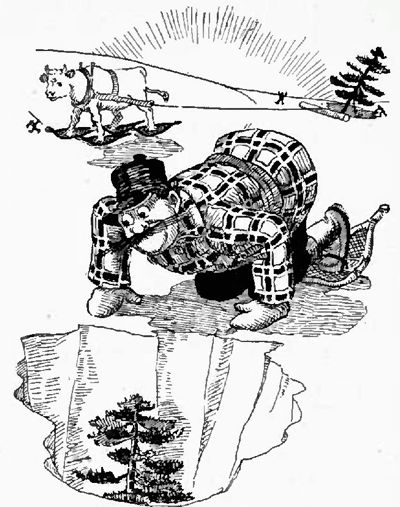
The year of the Two Winters they had winter all summer and then in the fall it turned colder. One day Big Joe set the boiling coffeepot on the stove and it froze so quick that the ice was hot. That was right after Paul had built the Great Lakes and that winter they froze clear to the bottom. They never would have thawed out if Paul had not chopped out the ice and hauled it out on shore for the sun to melt. He finally got all the ice thawed but he had to put in all new fish.
The next spring was the year the rain came up from China. It rained so hard and so long that the grass was all washed out by the roots and Paul had a great time feeding his cattle. Babe had to learn to eat pancakes like Benny. That was the time Paul used the straw hats for an emergency ration.
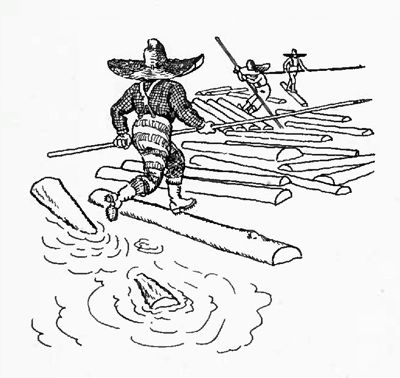
When Paul's drive came down, folks in the settlements were astonished to see all the river-pigs wearing huge straw hats. The reason for this was soon apparent. When the fodder ran out every man was politely requested to toss his hat into the ring. Hundreds of straw hats were used to make a lunch for Babe.

TALK about a job for Paul Bunyan! In 1913 the site of Westwood was primeval forest, sixty mountainous miles from the nearest railroad. Tractors, trucks and hundreds of horses freighted in materials before the railroad was extended and when the future residents arrived the town was complete to the last detail.
Not a shack in the town. Modern houses, sanitary sewers, waterworks, electricity, grade and high schools, hospital, church, clubs, up-to-date department store, cafeteria, dairy, packing house, and cold storage, theatre, soda fountains, garage and ball park—the 5,400 citizens of Westwood enjoy comfortable homes, good schools, year 'round employment at good wages, low living costs, and form one of the most-up-and-coming communities in the progressive State of California.

LUCY, Paul Bunyan's cow, was not, so far as we can learn, related in any way to either Babe or Benny. Statements that she was their mother are without basis in fact. The two oxen had been in Paul's possession for a long time before Lucy arrived on the scene.
No reliable data can be found as to the pedigree of this remarkable dairy animal. There are no official records of her butter-fat production nor is it known where or how Paul got her.
Paul always said that Lucy was part Jersey and part wolf. Maybe so. Her actions and methods of living seemed to justify the allegation of wolf ancestry, for she had an insatiable appetite and a roving disposition. Lucy ate everything in sight and could never be fed at the same camp with Babe or Benny. In fact, they quit trying to feed her at all but let her forage her own living. The Winter of the Deep Snow, when even the tallest White Pines were buried, Brimstone Bill outfitted Lucy with a set of Babe's old snowshoes and a pair of green goggles and turned her out to graze on the snowdrifts. At first she had some trouble with the new foot gear but once she learned to run them and shift gears without wrecking herself, she answered the call of the limitless snow fields and ran away all over North America until Paul decorated her with a bell borrowed from a buried church.

In spite of short rations she gave enough milk to keep six men busy skimming the cream. If she had been kept in a barn and fed regularly she might have made a milking record. When she fed on the evergreen trees and her milk got so strong of White Pine and Balsam that the men used it for cough medicine and linament, they quit serving the milk on the table and made butter out of it. By using this butter to grease the logging roads when the snow and ice thawed off, Paul was able to run his logging sleds all summer.
THE family life of Paul Bunyan, from all accounts, has been very happy. A charming glimpse of Mrs. Bunyan is given by Mr. E. S. Shepard of Rhinelander, Wis., who tells of working in Paul's camp on Round River in '62, the Winter of the Black Snow. Paul put him wheeling prune pits away from the cook camp. After he had worked at this job for three months Paul had him haul them all back again as Mrs. Bunyan, who was cooking at the camp, wanted to use them to make the hot fires necessary to cook her famous soft nosed pancakes.
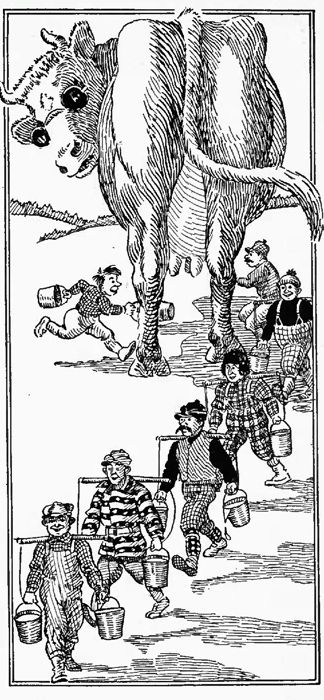
Mrs. Bunyan, at this time used to call the men to dinner by blowing into a woodpecker hole in an old hollow stub that stood near the door. In this stub there was a nest of owls that had one short wing and flew in circles. When Mr. Shepard made a sketch of Paul, Mrs. Bunyan, with wifely solicitude for his appearance, parted Paul's hair with a handaxe and combed it with an old crosscut saw.
From other sources we have fragmentary glimpses of Jean, Paul's youngest son. When Jean was three weeks old he jumped from his cradle one night and seizing an axe, chopped the four posts out from under his father's bed. The incident greatly tickled Paul, who used to brag about it to any one who would listen to him. "The boy is going to be a great logger some day," he would declare with fatherly pride.
The last we heard of Jean he was working for a lumber outfit in the South, lifting logging trains past one another on a single track railroad.
IT is no picnic to tackle the wilderness and turn the very forest itself into a commercial commodity delivered at the market. A logger needs plenty of brains and back bone.
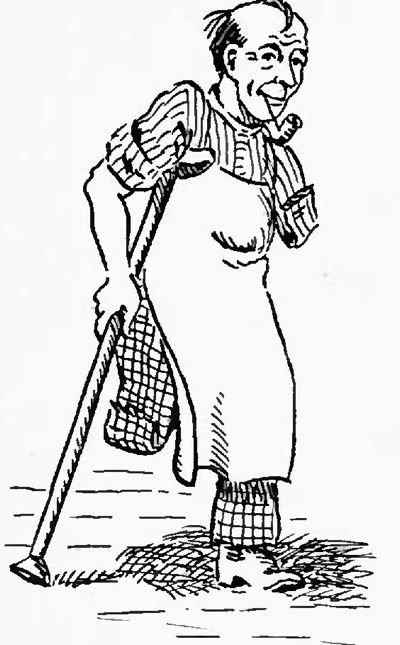
Paul Bunyan had his setbacks the same as every logger only his were worse. Being a pioneer he had to invent all his stuff as he went along. Many a time his plans were upset by the mistakes of some swivel-headed strawboss or incompetent foreman. The winter of the blue snow, Shot Gunderson had charge in the Big Tadpole River country. He landed all of his logs in a lake and in the spring when ready to drive he boomed the logs three times around the lake before he discovered there was no outlet to it. High hills surrounded the lake and the drivable stream was ten miles away. Apparently the logs were a total loss.
Then Paul came on the job himself and got busy. Calling in Sourdough Sam, the cook who made everything but coffee out of sourdough, he ordered him to mix enough sourdough to fill the big watertank. Hitching Babe to the tank, he hauled it over and dumped it into the lake. When it "riz", as Sam said, a mighty lava-like stream poured forth and carried the logs over the hills to the river. There is a landlocked lake in Northern Minnesota that is called "Sourdough Lake" to this day.
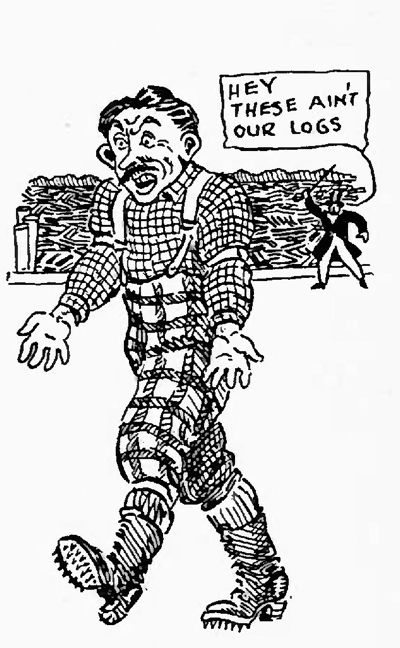
Chris Crosshaul was a careless cuss. He took a big drive down the Mississippi for Paul and when the logs were delivered in the New Orleans boom it was found that he had driven the wrong logs. The owners looked at the barkmarks and refused to accept them. It was up to Paul to drive them back upstream.
No one but Paul Bunyan would ever tackle a job like that. To drive logs upstream is impossible, but if you think a little thing like an impossibility could stop him, you don't know Paul Bunyan. He simply fed Babe a good big salt ration and drove him to the upper Mississippi to drink. Babe drank the river dry and sucked all the water upstream. The logs came up river faster than they went down.
BIG Ole was the Blacksmith at Paul's headquarters camp on the Big Onion. Ole had a cranky disposition but he was a skilled workman. No job in iron or steel was too big or too difficult for him. One of the cooks used to make doughnuts and have Ole punch the holes. He made the griddle on which Big Joe cast his pancakes, and the dinner horn that blew down ten acres of pine. Ole was the only man who could shoe Babe or Benny. Every time he made a set of shoes for Babe they had to open up another Minnesota iron mine. Ole once carried a pair of these shoes a mile and sunk knee deep into solid rock at every step. Babe cast a shoe while making a hard pull one day, and it was hurled for a mile and tore down forty acres of pine and injured eight Swedes that were swamping out skidways. Ole was also a mechanic and built the Downcutter, a rig like a mowing machine that cut down a swath of trees 500 feet wide.
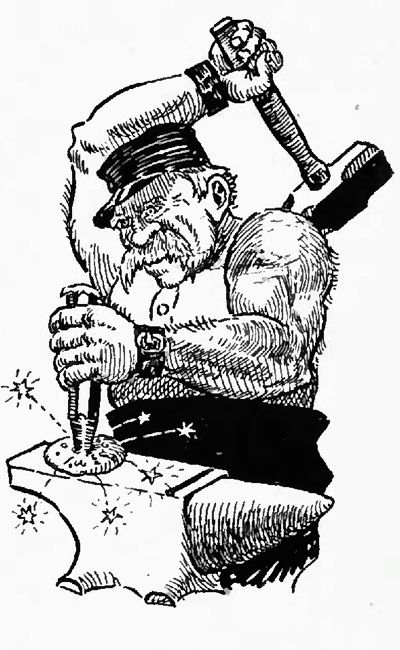
IN the early days, whenever Paul Bunyan was broke between logging seasons, he travelled around like other lumberjacks doing any kind of pioneering work he could find. He showed up in Washington about the time The Puget Construction Co. was building Puget Sound and Billy Puget was making records moving dirt with droves of dirt throwing badgers. Paul and Billy got into an argument over who had shovelled the most. Paul got mad and said he'd show Billy Puget and started to throw the dirt back again. Before Billy stopped him he had piled up the San Juan Islands.
WHEN a man gets the reputation in the woods of being a "good man" it refers only to physical prowess. Frequently he is challenged to fight by "good men" from other communities.

There was Pete Mufraw. "You know Joe Mufraw?" "Oui, two Joe Mufraw, one named Pete." That's the fellow. After Pete had licked everybody between Quebec and Bay Chaleur he started to look for Paul Bunyan. He bragged all over the country that he had worn out six pair of shoe-pacs looking for Paul. Finally he met up with him.
Paul was plowing with two yoke of steers and Pete Mufraw stopped at the brush-fence to watch the plow cut its way right through rocks and stumps. When they reached the end of the furrow Paul picked up the plow and the oxen with one arm and turned them around. Pete took one look and then wandered off down the trail muttering, "Hox an' hall! She's lift hox an' hall."
PAUL Bunyan started travelling before the steam cars were invented. He developed his own means of transportation and the railroads have never been able to catch up. Time is so valuable to Paul he has no time to fool around at sixty miles an hour.
In the early days he rode on the back of Babe, the Big Blue Ox. This had it's difficulties because he had to use a telescope to keep Babe's hind legs in view and the hooves of the ox created such havoc that after the settlements came into different parts of the country there were heavy damage claims to settle every trip.
Snowshoes were useful in winter but one trip on the webs cured Paul of depending upon them for transcontinental hikes. He started from Minnesota for Westwood one Spring morning. There was still snow in the woods so Paul wore his snowshoes. He soon ran out of the snow belt but kept right on without reducing speed. Crossing the desert the heat became oppressive, his mackinaws grew heavy and the snowshoes dragged his feet but it was too late to turn back.
When he arrived in California he discovered that the sun and hot sand had warped one of his shoes and pulled one foot out of line at every step, so instead of travelling on a bee line and hitting Westwood exactly, he came out at San Francisco. This made it necessary for him to travel an extra three hundred miles north. It was late that night when he pulled into Westwood and he had used up a whole day coming from Minnesota.
Paul's fast foot work made him a "good man on the round stuff" and in spite of his weight he had no trouble running around on the floating logs, even the small ones. It was said that Paul could spin a log till the bark came off and then run ashore on the bubbles. He once threw a peavy handle into the Mississippi at St. Louis and standing on it, poled up to Brainerd, Minnesota. Paul was a "white water bucko" and rode water so rough it would tear an ordinary man in two to drink out of the river.
JOHNNY Inkslinger was Paul's headquarters clerk. He invented bookkeeping about the time Paul invented logging. He was something of a genius and perfected his own office appliances to increase efficiency. His fountain pen was made by running a hose from a barrel of ink and with it he could "daub out a walk" quicker than the recipient of the pay-off could tie the knot in his tussick rope.

One winter Johnny left off crossing the "t's" and dotting the "i's" and saved nine barrels of ink. The lumberjacks accused him of using a split pencil to charge up the tobacco and socks they bought at the wanagan but this was just bunkshanty talk (is this the origin of the classic term "the bunk"?) for Johnny never cheated anyone.
HAVE you ever encountered the Mosquito of the North Country? You thought they were pretty well developed animals with keen appetites didn't you? Then you can appreciate what Paul Bunyan was up against when he was surrounded by the vast swarms of the giant ancestors of the present race of mosquitoes, getting their first taste of human victims. The present mosquito is but a degenerate remnant of the species. Now they rarely weigh more than a pound or measure more than fourteen or fifteen inches from tip to tip.
Paul had to keep his men and oxen in the camps with doors and windows barred. Men armed with pike-poles and axes fought off the insects that tore the shakes off the roof in their efforts to gain entrance. The big buck mosquitoes fought among themselves and trampled down the weaker members of the swarm and to this alone Paul Bunyan and his crew owe their lives.
Paul determined to conquer the mosquitoes before another season arrived. He thought of the big Bumble Bees back home and sent for several yoke of them. These, he hoped would destroy the mosquitoes. Sourdough Sam brought out two pair of the bees, overland on foot. There was no other way to travel for the flight of the beasts could not be controlled. Their wings were strapped with surcingles, they checked their stingers with Sam and walking shoes were provided for them. Sam brought them through without losing a bee.
The cure was worse than the original trouble. The Mosquitoes and the Bees made a hit with each other. They soon intermarried and their off-spring, as often happens, were worse than their parents. They had stingers fore-and-aft and could get you coming or going.
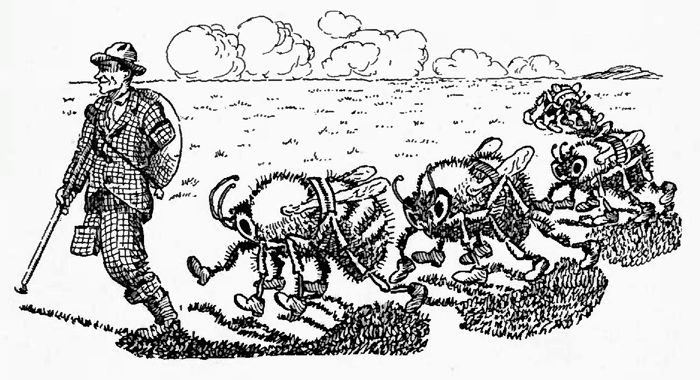
Their bee blood caused their downfall in the long run. Their craving for sweets could only be satisfied by sugar and molasses in large quantities, for what is a flower to an insect with a ten-gallon stomach? One day the whole tribe flew across Lake Superior to attack a fleet of ships bringing sugar to Paul's camps. They destroyed the ships but ate so much sugar they could not fly and all were drowned.
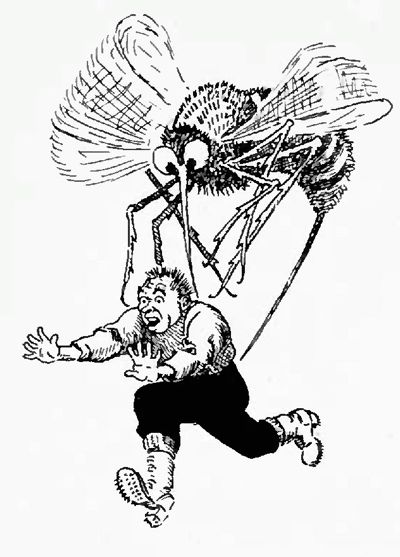
One pair of the original bees were kept at headquarters camp and provided honey for the pancakes for many years.
IF Paul Bunyan did not invent Geography he created a lot of it. The Great Lakes were first constructed to provide a water hole for Babe the Big Blue Ox. Just what year this work was done is not known but they were in use prior to the Year of the Two Winters.
The Winter Paul Bunyan logged off North Dakota he hauled water for his ice roads from the Great Lakes. One day when Brimstone Bill had Babe hitched to one of the old water tanks and was making his early morning trip, the tank sprung a leak when they were half way across Minnesota. Bill saved himself from drowning by climbing Babe's tail but all efforts to patch up the tank were in vain so the old tank was abandoned and replaced by one of the new ones. This was the beginning of the Mississippi River and the truth of this is established by the fact that the old Mississippi is still flowing.
The cooks in Paul's camps used a lot of water and to make things handy, they used to dig wells near the cook shanty. At headquarters on the Big Auger, on top of the hill near the mouth of the Little Gimlet, Paul dug a well so deep that it took all day for the bucket to fall to the water, and a week to haul it up. They had to run so many buckets that the well was forty feet in diameter. It was shored up with tamarac poles and when the camp was abandoned Paul pulled up this cribbing. Travellers who have visited the spot say that the sand has blown away until 178 feet of the well is sticking up into the air, forming a striking landmark.
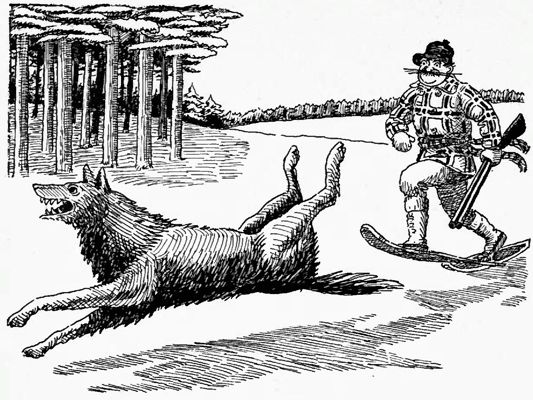
WHAT is camp without a dog? Paul Bunyan loved dogs as well as the next man but never would have one around that could not earn its keep. Paul's dogs had to work, hunt or catch rats. It took a good dog to kill the rats and mice in Paul's camps for the rodents picked up scraps of the buffalo milk pancakes and grew to be as big as two year old bears.
Elmer, the moose terrier, practiced up on the rats when he was a small pup and was soon able to catch a moose on the run and finish it with one shake. Elmer loafed around the cook camp and if the meat supply happened to run low the cook would put the dog out the door and say, "Bring in a moose." Elmer would run into the timber, catch a moose and bring it in and repeat the performance until, after a few minutes work, the cook figured he had enough for a mess and would call the dog in.
Sport, the reversible dog, was really the best hunter. He was part wolf and part elephant hound and was raised on bear milk. One night when Sport was quite young, he was playing around in the horse barn and Paul, mistaking him for a mouse, threw a hand axe at him. The axe cut the dog in two but Paul, instantly realizing what had happened, quickly stuck the two halves together, gave the pup first aid and bandaged him up. With careful nursing the dog soon recovered and then it was seen that Paul in his haste had twisted the two halves so that the hind legs pointed straight up. This proved to be an advantage for the dog learned to run on one pair of legs for a while and then flop over without loss of speed and run on the other pair. Because of this he never tired and anything he started after got caught. Sport never got his full growth. While still a pup he broke through four feet of ice on Lake Superior and was drowned.
As a hunter, Paul would make old Nimrod himself look like a city dude lost from his guide. He was also a good fisherman. Oldtimers tell of seeing Paul as a small boy, fishing off the Atlantic Coast. He would sail out early in the morning in his three-mast schooner and wade back before breakfast with his boat full of fish on his shoulder.
About this time he got his shot gun that required four dishpans full of powder and a keg of spikes to load each barrel. With this gun he could shoot geese so high in the air they would spoil before reaching the ground.
Tracking was Paul's favorite sport and no trail was too old or too dim for him to follow. He once came across the skeleton of a moose that had died of old age and, just for curiosity, picked up the tracks of the animal and spent the whole afternoon following its trail back to the place where it was born.
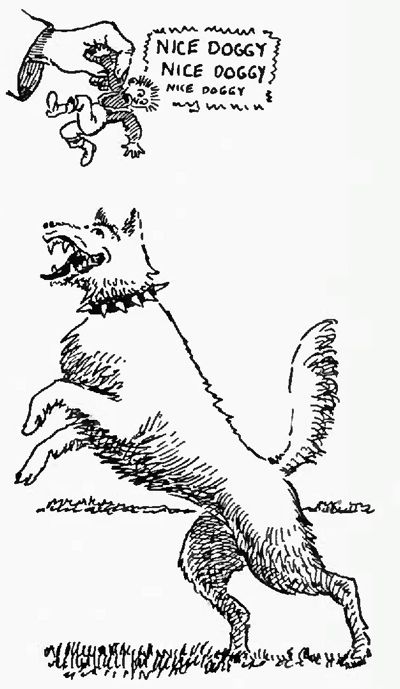
The shaggy dog that spent most of his time pretending to sleep in front of Johnny Inkslinger's counter in the camp office was Fido, the watch dog. Fido was the bug-bear (not bearer, just bear) of the greenhorns. They were told that Paul starved Fido all winter and then, just before payday, fed him all the swampers, barn boys and student bull-cooks. The very marrow was frozen in their heads at the thought of being turned into dog food. Their fears were groundless for Paul would never let a dog go hungry or mistreat a human being. Fido was fed all the watch peddlers, tailors' agents, and camp inspectors and thus served a very useful purpose.

WHEN Paul Bunyan took up efficiency engineering he went at the job with all his customary thoroughness. He did not fool around clocking the crew with a stop watch, counting motions and deducting the ones used for borrowing chews, going for drinks, dodging the boss and preparing for quitting time. He decided to cut out labor altogether.
"What's the use," said Paul, "of all this sawing, swamping, skidding, decking, grading and icing roads, loading, hauling and landing? The object of the game is to get the trees to the landing, ain't it? Well, why not do it and get it off your mind?"
So he hitched Babe to a section of land and snaked in the whole 640 acres at one drag. At the landing the trees were cut off just like shearing a sheep and the denuded section hauled back to it's original place. This simplified matters and made the work a lot easier. Six trips a day, six days a week just cleaned up a township for section 37 was never hauled back to the woods on Saturday night but was left on the landing to wash away in the early spring when the drive went out.
Documentary evidence of the truth of this is offered by the United States government surveys. Look at any map that shows the land subdivisions and you will never find a township with more than thirty-six sections.
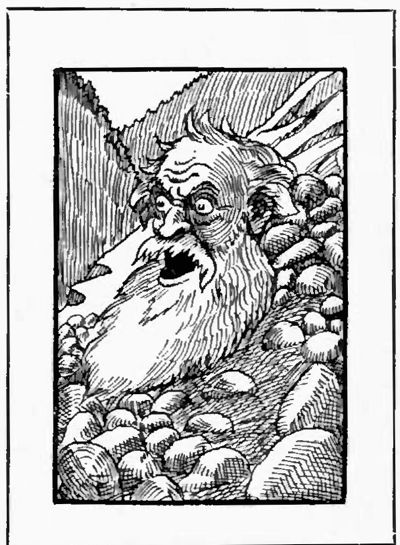 Westwood, Cal. Dec. 32 (Special) Hauling
in the last section 37 in California today.
Brimstone Bill, the bullwhacker in
charge of Babe, the Big Blue Ox, met
with an accident that would have been
fatal but for the prompt action of Paul
Bunyan. The section skidded on a bad
turn and buried Brimstone against the
mountain side. Mr. Bunyan hitched
Babe to the mountain and pulled it
away, releasing Brimstone who is recovering
in the Westwood Hospital.
Westwood, Cal. Dec. 32 (Special) Hauling
in the last section 37 in California today.
Brimstone Bill, the bullwhacker in
charge of Babe, the Big Blue Ox, met
with an accident that would have been
fatal but for the prompt action of Paul
Bunyan. The section skidded on a bad
turn and buried Brimstone against the
mountain side. Mr. Bunyan hitched
Babe to the mountain and pulled it
away, releasing Brimstone who is recovering
in the Westwood Hospital.
The foregoing statement, previously published, has caused some controversy. Mr. T. S. Sowell of Miami, Florida wrote to us citing the townships in his State that have sections numbered 37 to 40. He said that the government survey had been complicated by the old Spanish land grants. We put the matter up to Paul Bunyan and from his camp near Westwood came this reply:
Red River Advertising Department.
Dear Sir: Yes sir, I remember those sections and a lot of bother they made me too. One winter when I was starting the White Pine business and snaking sections down to the Atlantic Ocean, a man from Florida came along and ordered a bunch of sections delivered down to his place. He wanted to see if he could grow the same kind of White Pine down there. I yarded out a nice bunch of sections and next summer when my drive was in and I wasn't busy I took a crew of Canada Boys and Mainites and poled them down the coast. When I come to collect they said this man was gone looking for a Fountain of Youth or some fool thing.
I don't know what luck he had with his White Pine ranch. I never seen them again. I had a lot of other things to tend to and clean forgot it till you sent me Mr. Sowell's letter. Maybe that man was a Spaniard I don't know.
Yours respectively,
P. BUNYAN.
FROM 1917 to 1920 Paul Bunyan was busy toting the supplies and building camps for a bunch of husky young fellow-Americans who had a contract on the other side of the Atlantic, showing a certain prominent European (who is now logging in Holland) how they log in the United States.
After his service overseas with the A. E. F., Paul couldn't get back to the States quick enough. Airplanes were too slow so Paul embarked in his Bark Canoe, the one he used on the Big Onion the year he drove logs upstream. When he threw the old paddle into high he sure rambled and the sea was covered with dead fish that broke their backs trying to watch him coming and going.
As he shoved off from France, Paul sent a wireless to New York but passed the Statue of Liberty three lengths ahead of the message. From New York to Westwood he travelled on skis. When the home folks asked him if the Allegheney Mountains and the Rockies had bothered him, Paul replied, "I didn't notice any mountains but the trail was a little bumpy in a couple of spots."
BACK in the early days, when his camps were so far from anywhere that the wolves following the tote-teams got lost in the woods, Paul Bunyan made no attempt to keep in touch with the trade. What's the use when every letter that comes in is about things that happened the year before?
Since he came to Westwood Paul has renewed old friendships, formed new ones and kept close contact with the world. Everyone expects great things of Paul Bunyan and with the Red River outfit back of him he has the chance of his life to make good. Continuous production keeps a full assortment of stock on hand. Customers in all parts of America find Westwood a dependable source of supply.
Here is an instance. This old friend of Paul's, a prominent furniture manufacturer in the Lake States, was disappointed because an item he wanted for immediate shipment was not in stock in the grade and thickness required. He wrote the letter shown below and was given an explanation of the facts in the case in the accompanying reply.
Click on the image to enlarge
PAUL BUNYAN'S PINE
CALIFORNIA WHITE And SUGAR PINES
"Specified where economy is a vital factor, or where the best is used regardless of cost."
WHITE FIR INCENSE CEDAR
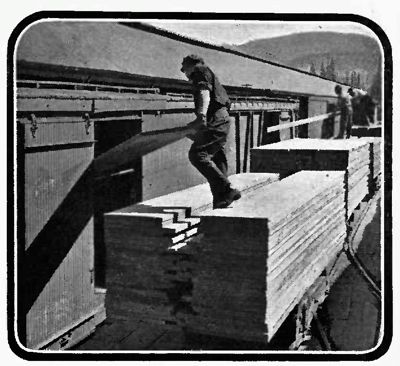
"The old-fashioned White Pine our grandfathers used!"
How often have you wished for it, the soft, even textured, easy-working wood that took paint so well and weathered the years without a warp or a check?
Here it is, friends, better than ever,—clear plank 48 inches wide if you want them. Red River products excel in workmanship, precise cutting, perfect seasoning. YARD STOCKS, all items and grades, boards, dimension, moldings, lath and sidings. FACTORY LUMBER, sash and door cuttings and industrial cuttings for any requirement. BOX SHOOKS and crate stocks of every description. SASH AND DOORS, standard and made to order. PATTERN STOCK, large sizes, easy working, durable.
Saving in working-up costs, by hand or machine; light weight and the superior quality,—grade for grade, make PAUL BUNYAN'S PINES the most profitable to buy, to work or to sell. Distributed to all parts of America and to foreign countries.
Largest Manufacturers of California Pines.
"Producers of White Pine for over Half a Century."
The RED RIVER LUMBER CO.
T. B. WALKER, President.
GILBERT M. WALKER, Vice President FLETCHER L. WALKER, Treasurer
WILLIS J. WALKER, Vice President ARCHIE D. WALKER, Secretary
Mills, Factories & Sales Office, R. F. Pray, Resident Mgr. WESTWOOD CALIF.
General Office and Sales, 807 Hennepin Ave., MINNEAPOLIS, MINN.
Yards and Sales Office, 2452 Loomis St., CHICAGO, ILL.
Sales Office, 307 Monadnock Bldg., SAN FRANCISCO, CALIF.
Sales Office, 832 Union Oil Bldg., LOS ANGELES, CALIF,
Extra Copies of This Book Mailed Free Upon Request.
Transcriber's Notes:
This book has no table of contents, since it has no chapters. It has no list of illustration, since most of the illustrations lacked captions. Instead, it is a book of short stories about Paul Bunyan, which is part advertising for a lumber company and part stories of "America's only myth."
The use of "its" and "it's" has been preserved as in the original publication.
Errors in punctuation were not corrected unless otherwise noted below:
List of Corrections:
On page 3, a comma was added after "1914".
On page 4, "siezed" was replaced with "seized".
On page 6, a comma was added after "Oregonian", a comma was added after "Ida V. Turney", and series of three asterisks were replaced with ellipses.
On page 7, a comma was added after "the big blue ox" and an extra period at the end of the page was removed.
On page 11, a comma was added after "concrete mixers" and a period was added after "Volcano in America".
On page 17, "regularwork" was replaced with "regular work".
On page 18, "for-and-aft" was replaced with "fore-and-aft".
On page 22, a comma was added after "Paul Bunyan's cow".
On page 23, a comma was added after "camp", a missing period was added to "Mrs", and "siezing" was replaced with "seizing".
On page 24, "everthing" was replaced with "everything".
On page 29, "cook's" was replaced with "cooks".
On page 30, a comma was added after "reversible dog".
On page 32, an open quotation mark was added before "of all".
On page 35, "Unoin Oil" was replaced with "Union Oil" and "Los Angles" was replaced with "Los Angeles".